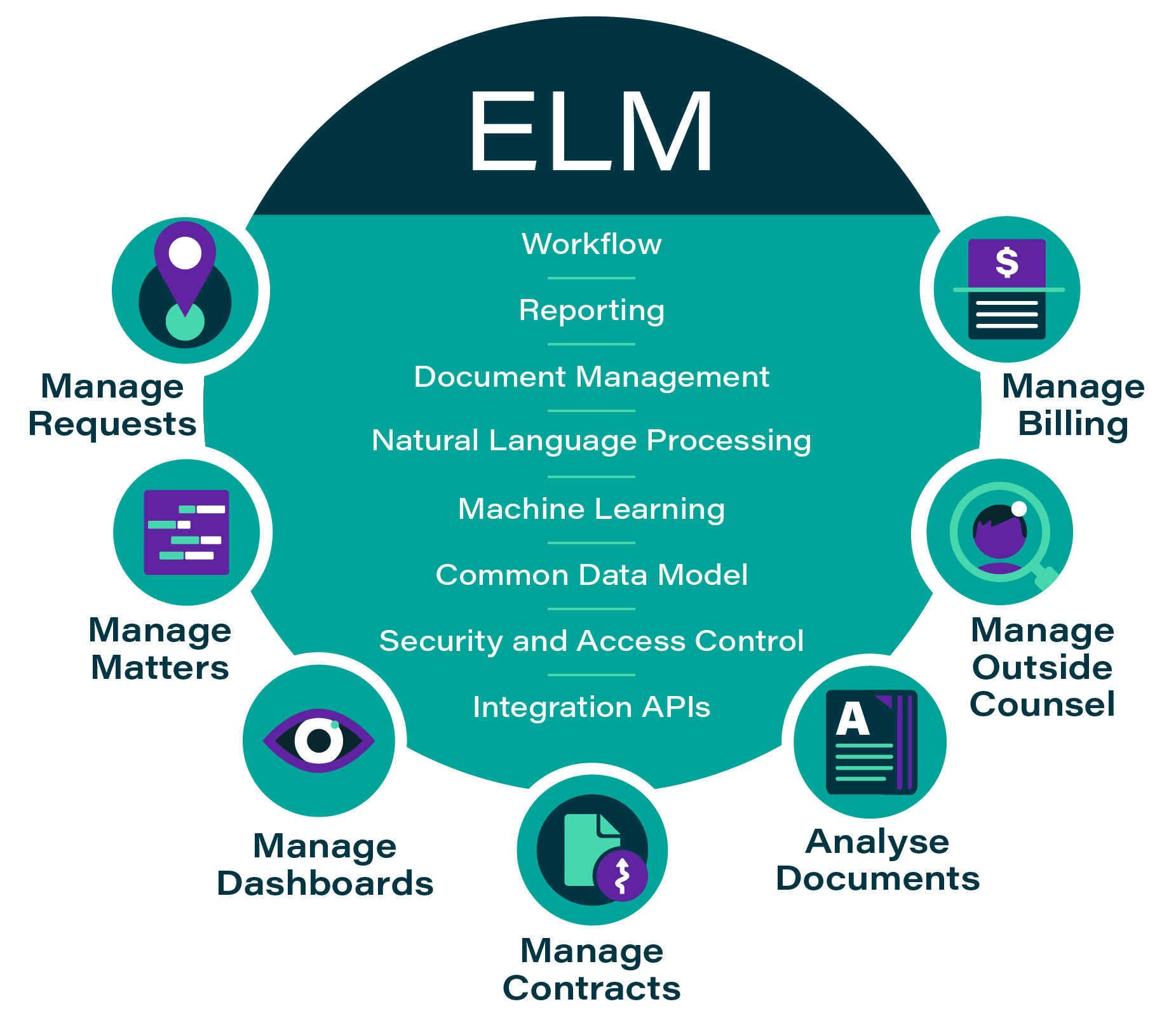When we launched Elevate, we believed that the business of law integrated seamlessly into the business’s day-to-day (what we call ‘Law in the Core’) would emerge from the event-driven Advice of Law that law firm experts provide. The business of law would be digital, scalable, reduce human error and waste, reduce cycle time, free up human resources to handle exceptions or provide better service, and allow companies to take advantage of their explosion of data to analyse, predict, and plan (what we call ‘Digital Law’).
Point of View
Legal Technology and Digital
We believe the future will be better than the past. Therefore, we are committed to ‘Machines and Expertise in Everything’ because machines will augment and improve people’s experience, not replace them.

However, a business can’t just leap from the minds and labor of experts at law firms to a digital, data-driven, AI-powered future. Arriving at the Digital Law future requires patiently stepping through stages, each step standing firmly on the foundation of the stage before. Each stage takes time, multi-disciplinary expertise, investment, and committed leadership.
It might be presumptuous to compare this concept of the emergence of Digital Law to the vision of a human settlement on Mars, but there are parallels. Wernher von Braun wrote the first technical study on the feasibility of a human mission to Mars (The Mars Project) in 1948, updated in 1968 for NASA, based on the Antarctic expeditions of the day. He predicted the technosocial need for governments, people, universities, and companies to collaborate, invest in, and invent technological breakthroughs (e.g., reliable rocket-booster technology, efficient liquid-fuel propellant, and cost-effective reusable components). These breakthroughs have brought this vision within reach today – hello, SpaceX! While the Digital Law future we imagine is still a long way off, we see tremendous momentum, with industry leaders collaborating to work on business of law problems, such as optimising contracting.
Legal Tech Today
The Covid pandemic sent legal professionals out of the office and into their homes, where they had to work with customers, colleagues, and courts. The crisis made it clear that legal tech and digital tools are essential to resilient business operations and service. Corporate law departments, pressured by increasing workloads and budget constraints, are turning to technology to automate work and improve productivity – and they are demanding their law firms be tech-enabled, too. Law firms, driven by the pandemic crisis and changing client expectations, are investing more in technology to improve client service and their operations, productivity, and efficiency.
The above contract optimization example illustrates the range of point solutions to be assembled and managed to resolve business of law problems. Point solution designs tackle a single, specific problem well – often with the ability to start fast.
There’s a rub, however. If you decide on a point solution, the next time you need a piece of software, you’ll have to start from scratch all over again.

- Incoherent UX and independent workstreams – the user experience changes across different software tools
- Partial integration or brittle APIs – configurations and integrations cross software tools need continuous management as updates are released
- Siloed data – data sits in different software silos, restricting the ability of AI and data science to mine it for insights, predictions, or decisions
- Permission and security management – access permissions need management in multiple software tools
- Lack of scalability – all these challenges increase with scale, leading ultimately to unmanageable complexity
We work with many customers who used fewer than five software tools a decade ago (e.g., ebilling, document management) – and who today work with over thirty. The above problems have not quite become unmanageable, but they are getting to that point fast.
Elevate’s Enterprise Legal Management software platform for legal ops offers AI-powered modules with time-to-value as short as four weeks.
Successful legal tech projects start by picking a sure-fire use case, rolling out small, proving value, and scaling. It’s what comes next that gets interesting. After you’ve established value once, do you do it again? Do you initiate a new search for needs, software suppliers, solutions, etc.?
With point solutions, this becomes a fact of life. It can mean having a different software provider for workflow, dashboards, document management, contract analytics, ebilling, RFPs, etc., or building new functionality in-house, which has its own set of drawbacks. But with an ELM platform, you simply switch on a new module and train your users how to use the new features, which is often intuitive because the UI is the same as the software they are already using.

Managing Change to Become Digital
Technology is not an end unto itself. Instead, it’s a scaffolding for new ways of working or a catalyst for digital transformation, the phenomenon of technology changing how people conduct business.
Humans are wired to resist change, with numerous studies showing we have a strong preference for maintaining the status quo, even when we complain about it. Often people overlook the importance of change management in successful legal tech implementations. They see it as an ‘add-on’ to the more technical aspects of the project. Those who underestimate the importance of change management during the implementation often fail to achieve the desired business outcomes.
The Point Solution Dilemma
- Each point solution supplier needs management
- The user experience changes across the different software tools depending on the workstream, creating a natural human-nature barrier to adoption
- Configurations and integrations between software need continuous management as updates are released
- Data sits in different software silos, restricting the ability of AI and data science to mine it for insights, predictions, or decisions
- Access permissions need management in multiple software tools
- All of the above challenges increase with scale, leading ultimately to unmanageable complexity
Executive Sponsorship
Having active sponsorship for change at a senior executive level is vital to success. This sponsor must be active and visible to the project team and all stakeholders.
Stakeholder Buy-in
Executive sponsorship is not enough. It is important to identify the key project stakeholders and stakeholder groups affected directly or indirectly. Some of these groups or individuals may be fully on board with the program and may require very little management in terms of expectations. Where possible, start with this group and have them communicate their achievements attributable to the change.
Manage Resistance
There are likely to be stakeholders who have other priorities or may be resistant to the change. Identifying and managing this resistance is important if the project is to succeed. There are tools and techniques to overcome this resistance, e.g., education and communication, even negotiation and bargaining. Coercion is the tool of last resort since it is often counter-productive.
Involve People
Changing even routine tasks requires learning a new way of working and may even provide uncomfortable exposure to and interaction with unfamiliar business processes and data. For example, with ebilling, manual invoice checks and approvals are replaced by AI-powered, automated rules-based processing. As part of the planning phase, it is vital to engage and involve team members whose day-to-day work will be affected. Work with them to understand the current business processes and design the new ones, identifying the needs for change and the improvements.
Measure and Report Impact
It may seem obvious that identifying and measuring the benefits or ROI achieved is vital to successful project implementation. Sometimes potential benefits are not identified before the decision to implement change. Still, it is vital that they are captured and reported, including the benefits realized beyond the implementation timescale. Most often, benefits are realized well after the go-live date.
Communicate
Unless everyone has a clear vision and understanding of the potential benefits, change can be a difficult path. Change management is the practice of guiding, educating, encouraging, and supporting the organization through a transition. It takes conscious effort to learn something new. Communication is vital when presenting changes and benefits. Communicate widely why the organization decided to make the change and benefit the organization and individuals personally.
At the project launch, the executive sponsor and change team should inform the company about the project, its objectives, the expected benefits, key milestones, membership, and roles of the project team. The communication plan should provide progress updates as the project unfolds, communicating new process designs and future changes.
The broader the communication of potential changes, the more likely people will understand the reasons, believe in the benefits, and be open and accepting of the change. It will also help identify potential project champions or early adopters who will prove invaluable in reinforcing the change among their peers.
Enable
Training is critical in preparing the company for a change. The project team should plan the training, the delivery methods, the level and nature of end-user documentation, and how the team will measure the effectiveness of the training. The training courses and documentation should incorporate the business process information alongside the change messages and reasons for change. Tailor training and documentation to the depth of knowledge that different individuals need, from high-level overviews to power-user level details.
Providing help desk services or intensive one-to-one assistance will be especially valuable in the immediate post-go-live period. In addition, this investment will support the go-live process and create useful knowledge for the future, e.g., for new-joiner training programs.
Successful technology projects unleash the transformative power of Digital Law to manage risks better and grow profits. Data is re-envisioned as a business asset that, with the application of artificial intelligence, natural language processing, and predictive analytics, can provide new, actionable insights and create wholly new value.
Contact Us
